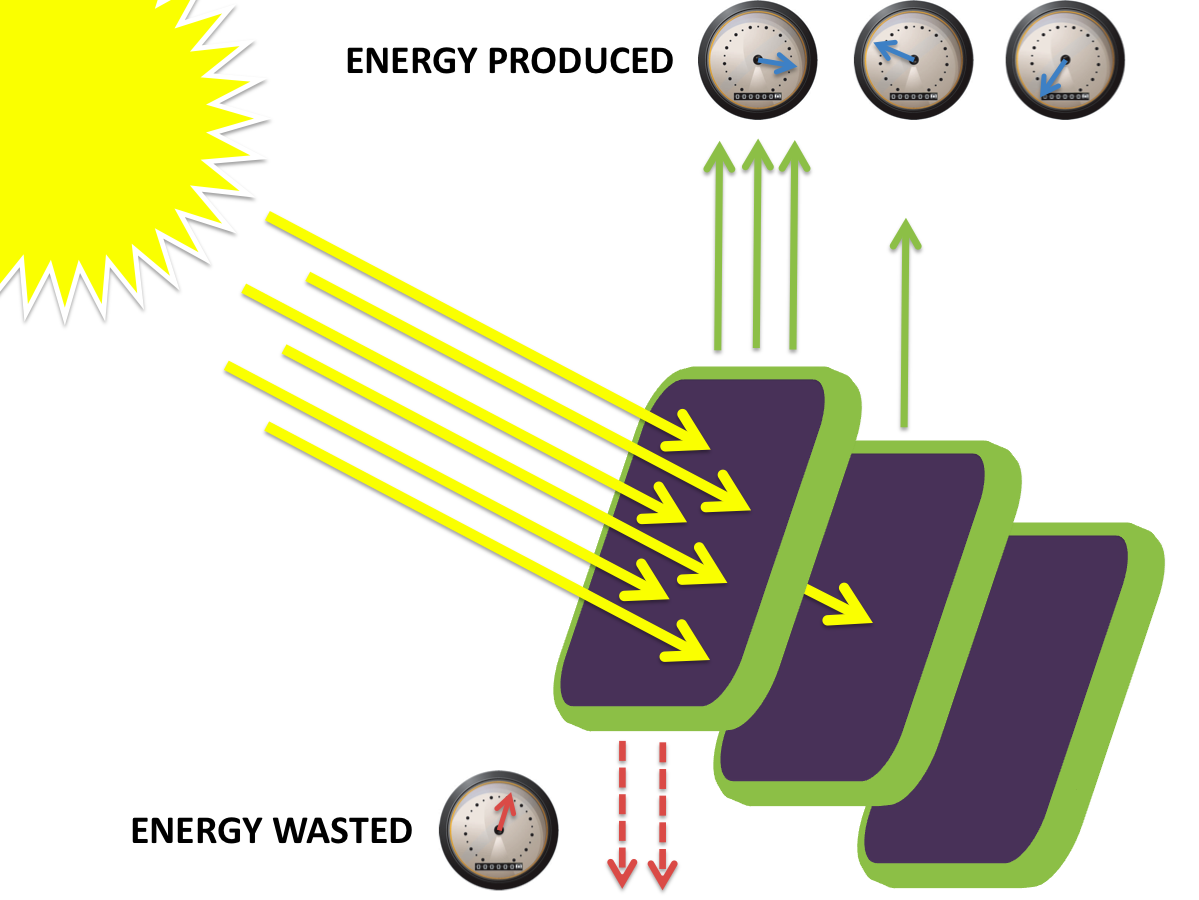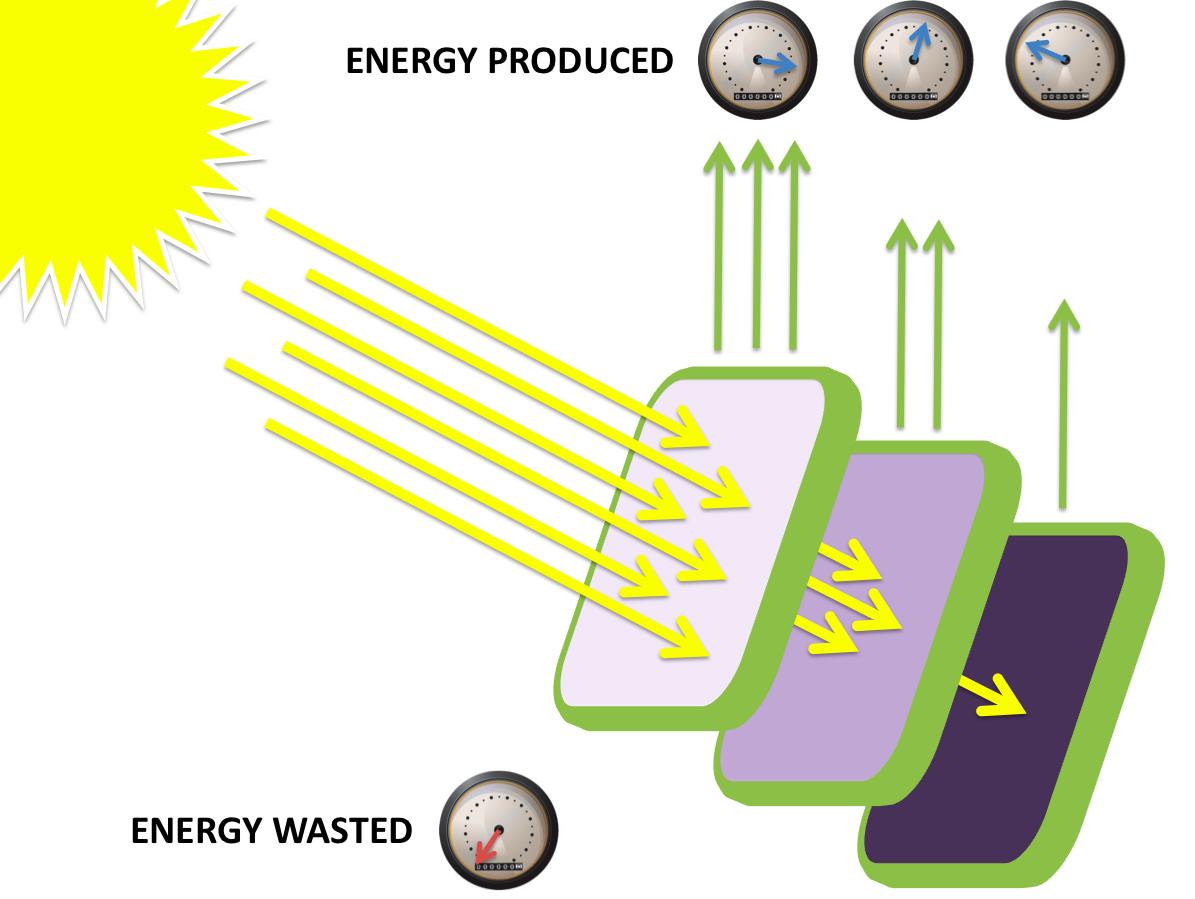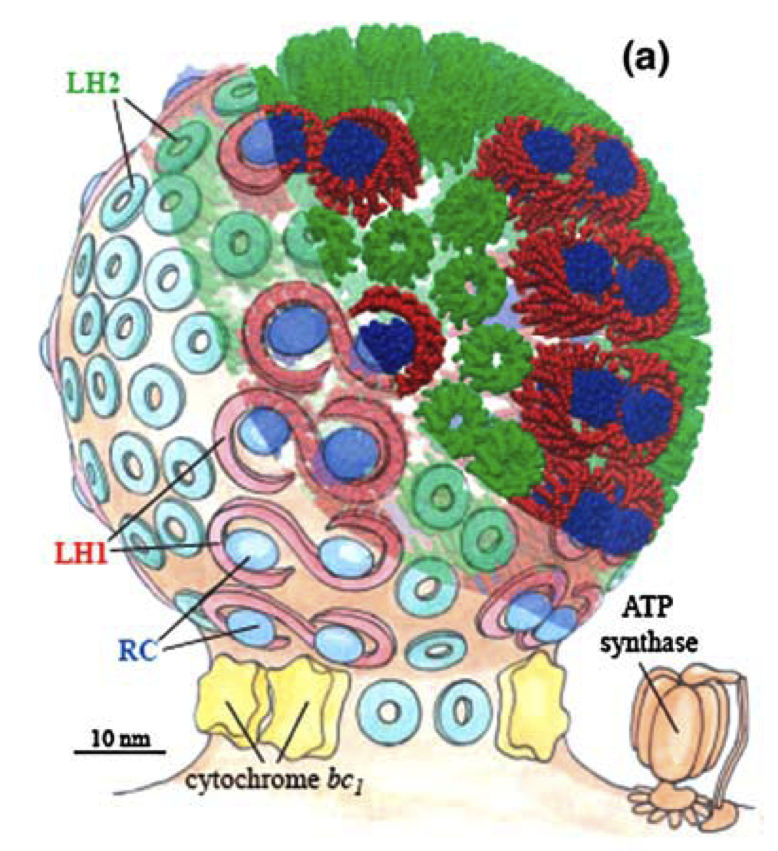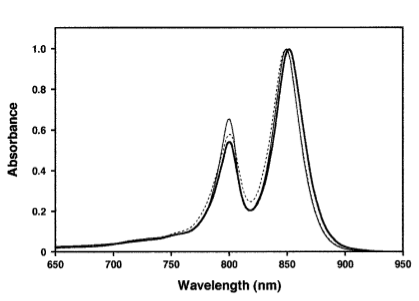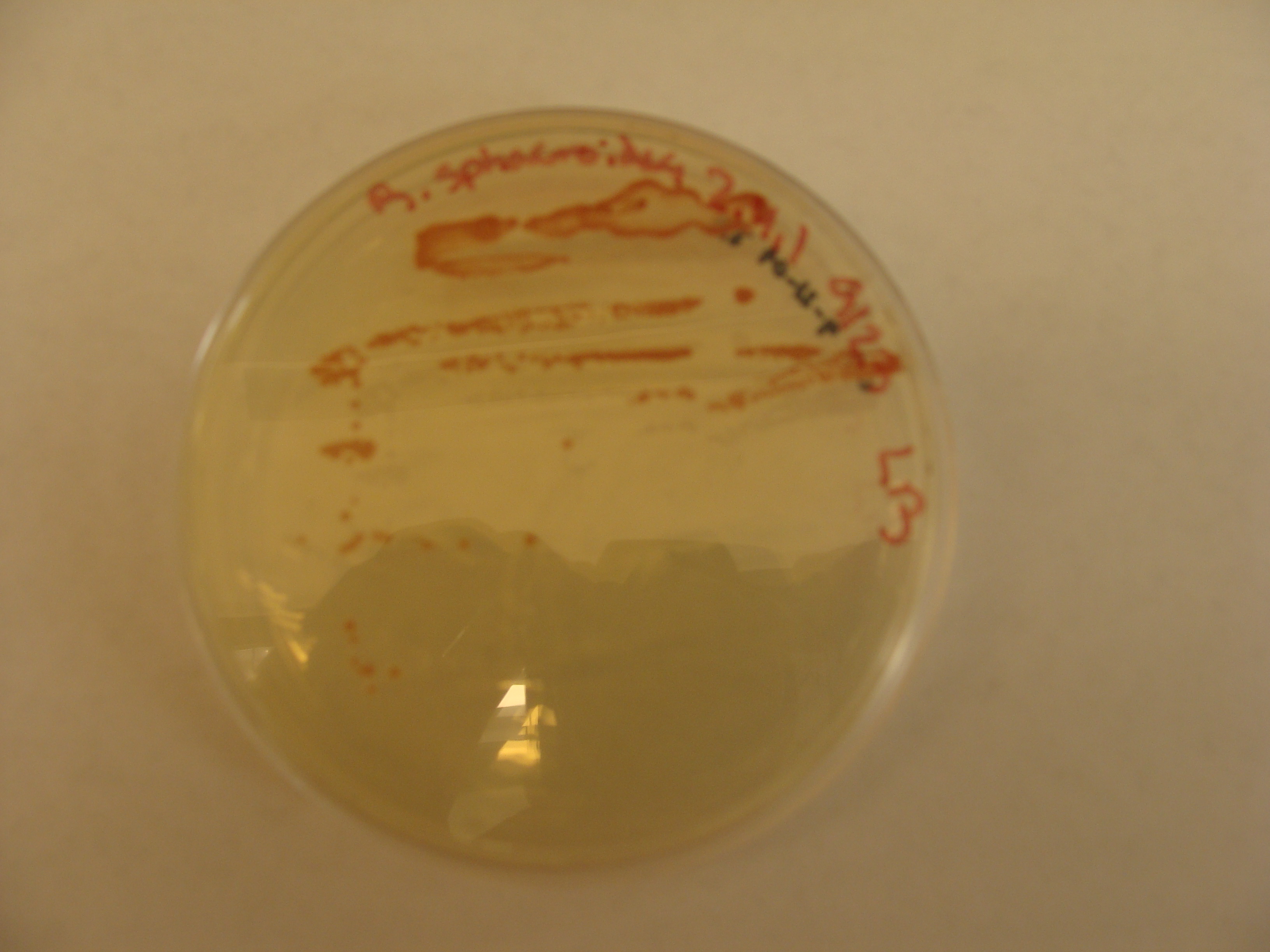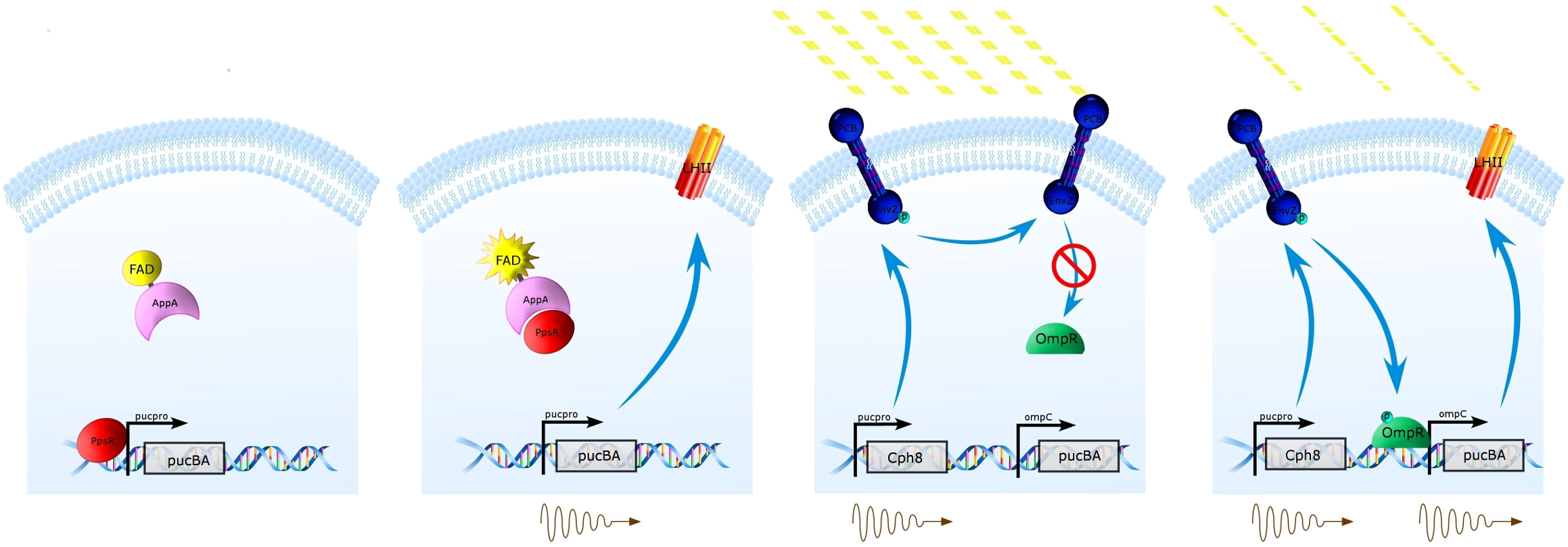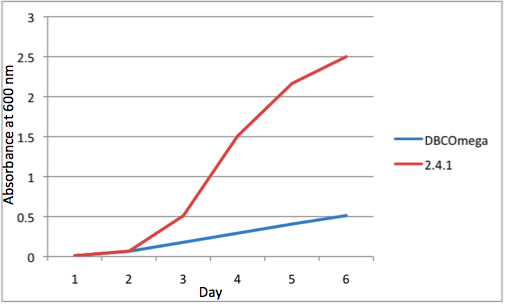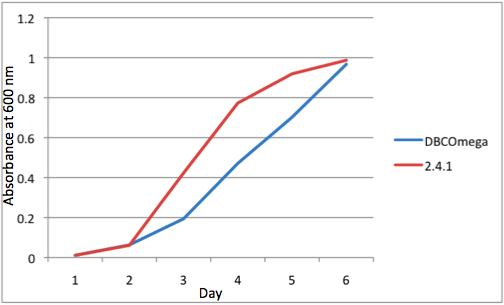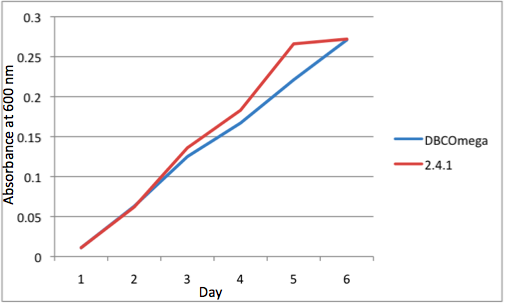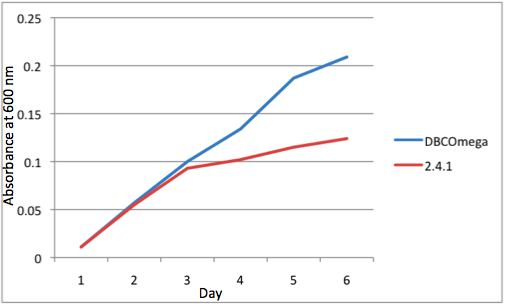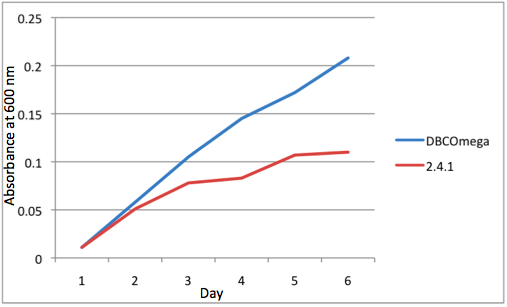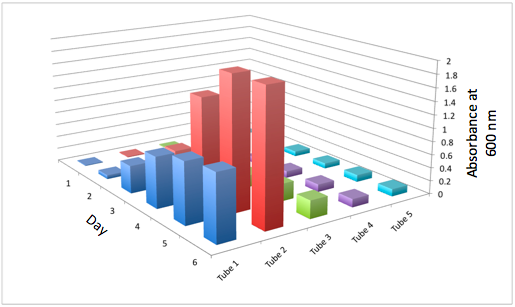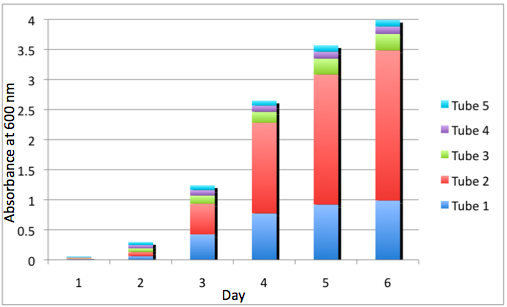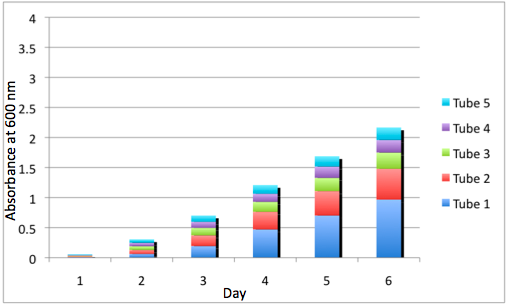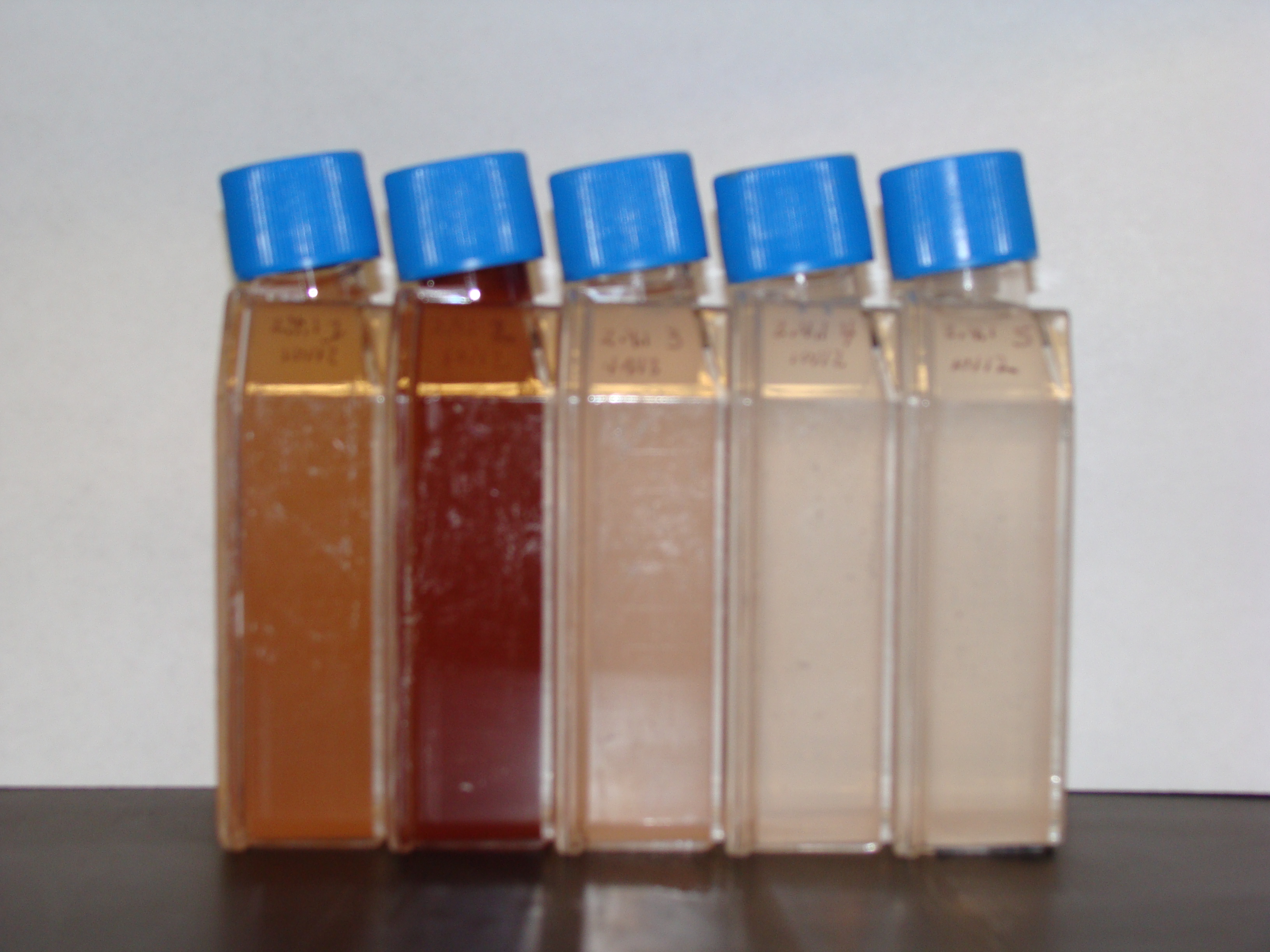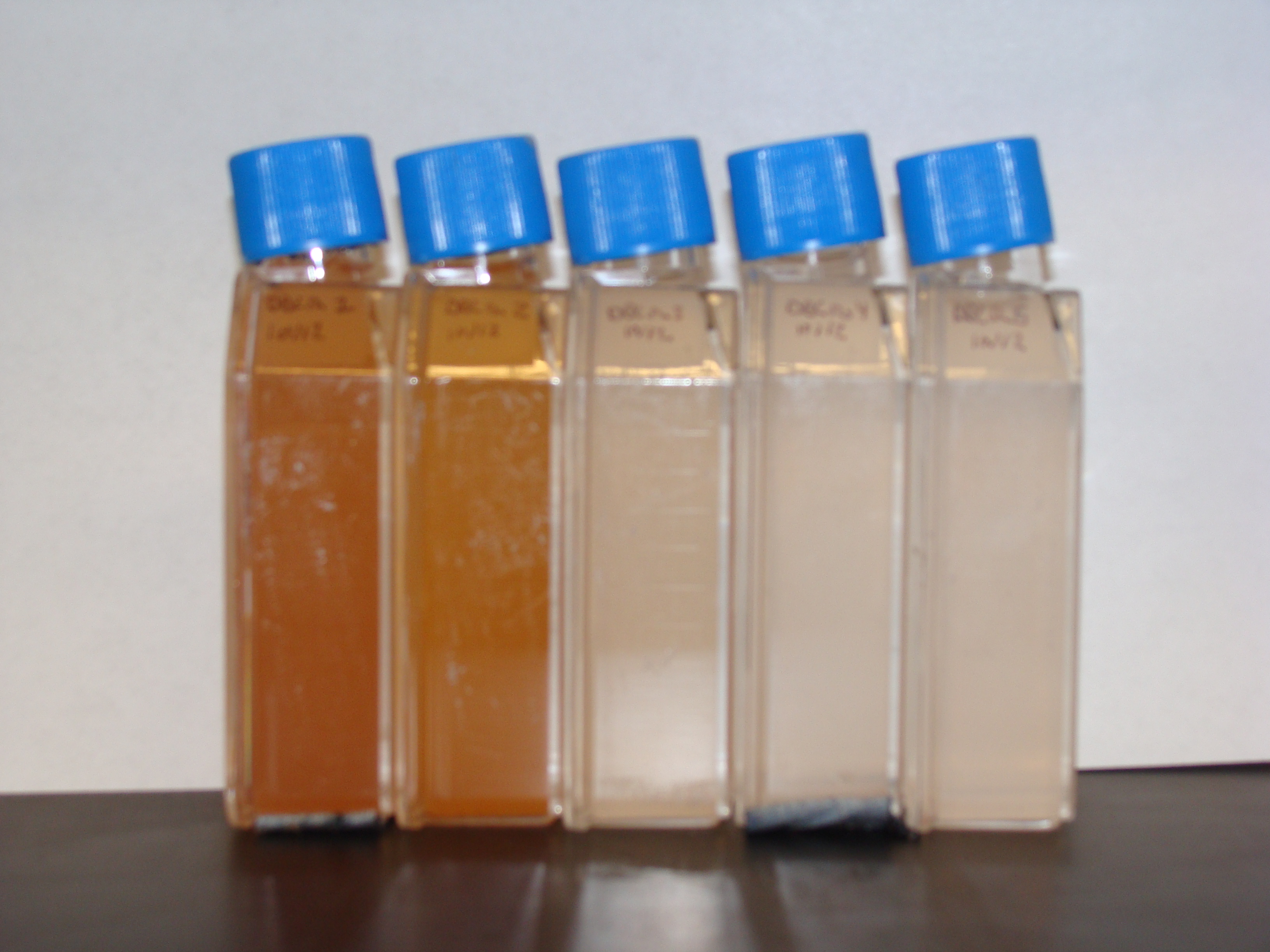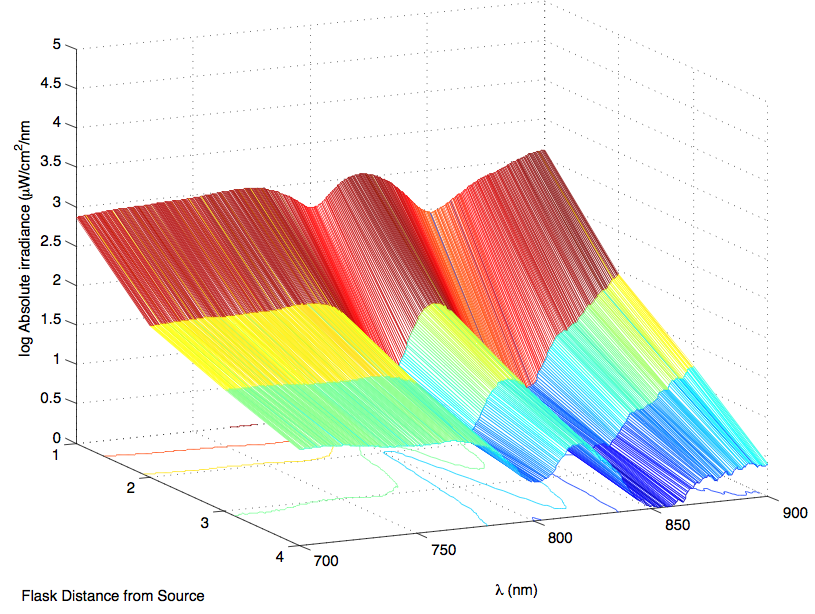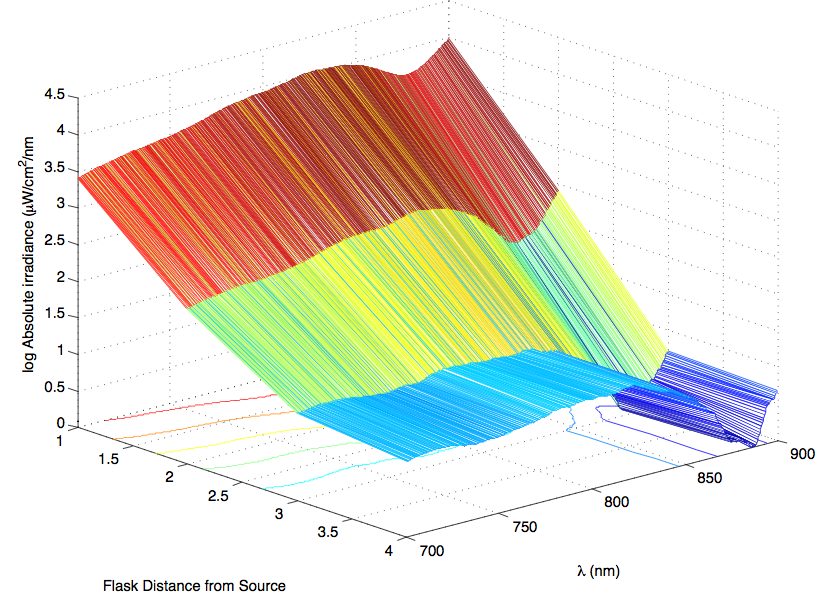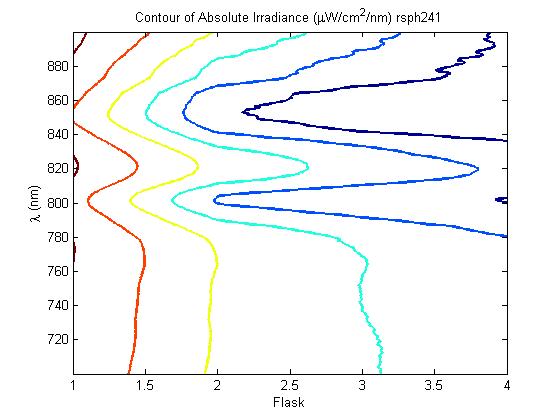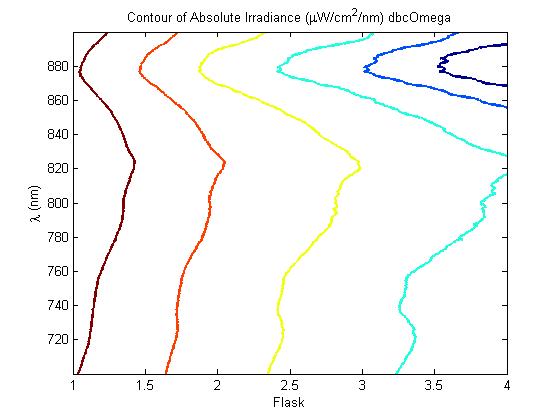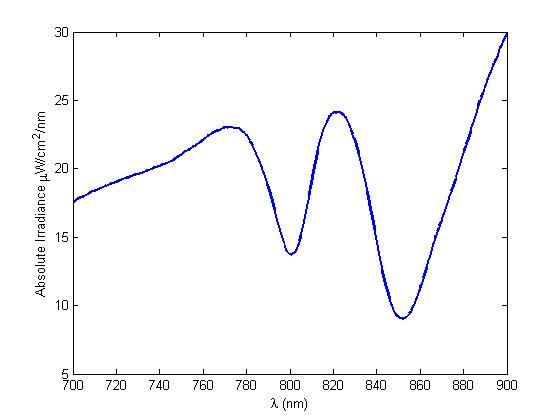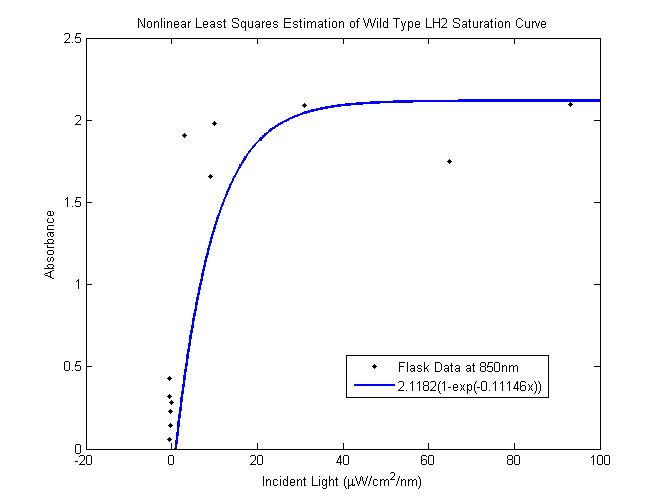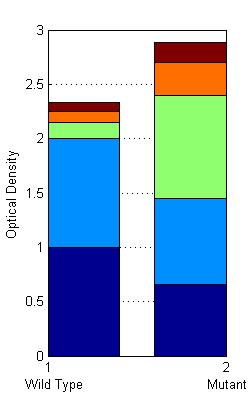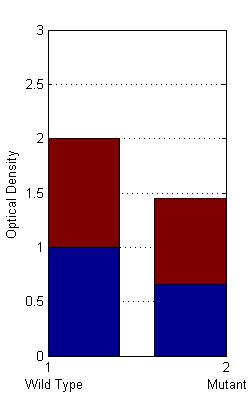Team:Wash U/Project
From 2009.igem.org
(→Conclusion and Future Work) |
(→Results) |
||
| (56 intermediate revisions not shown) | |||
| Line 6: | Line 6: | ||
== '''Introduction''' == | == '''Introduction''' == | ||
<font size="2"> | <font size="2"> | ||
| - | Our project goal is to maximize the photosynthetic productivity | + | Our project goal is to maximize the photosynthetic productivity of a series of photobioreactors containing ''Rhodobacter sphaeroides'' under both high and low light intensities by synthetically regulating the size of the light-harvesting antenna complex LH2. We chose to undertake such a project using ''R. sphaeroides'' due to its well-characterized photosynthetic and genetic system. |
| - | The antenna system functions to expand the spectrum of light available for photosynthesis by absorbing different wavelengths than that of the reaction center. Essentially, it is like the dish around the main receiver of any antenna. Marine bacteria, such as ''R. sphaeroides'', evolved very large antenna complexes to absorb light in a natural environment where there is great competition for photons. As a result, the photosynthetic machinery is saturated at low light intensities in a synthetic non-competitive environment, such as a photobioreactor. This causes up to 95% of incidental photons to be dissipated as heat or fluorescence by bacteria through a process called Non-Photochemical Quenching (NPQ) (Mussgnug et al., 2007). In essence, these photons are being wasted as NPQ reduces light penetration into and across bioreactors and starves the shaded cells for for photons. One method that has been shown to improve photosynthetic productivity in photobioreactors is the reduction of light-harvesting antenna sizes (Polle et al., 2002, Mussgnug et al., 2007). Though, current approaches to this end are difficult to precisely control from the perspective of biological engineering and synthetic biology. | + | The antenna system functions to expand the spectrum of light available for photosynthesis by absorbing different wavelengths than that of the reaction center. Essentially, it is like the dish around the main receiver of any antenna. Marine bacteria, such as ''R. sphaeroides'', evolved very large antenna complexes to absorb light in a natural environment, where there is great competition for photons. As a result, the photosynthetic machinery is saturated at low light intensities in a synthetic non-competitive environment, such as a photobioreactor. This causes up to 95% of incidental photons to be dissipated as heat or fluorescence by bacteria through a process called Non-Photochemical Quenching (NPQ) (Mussgnug et al., 2007). In essence, these photons are being wasted as NPQ reduces light penetration into and across bioreactors and starves the shaded cells for for photons. One method that has been shown to improve photosynthetic productivity in photobioreactors is the reduction of light-harvesting antenna sizes (Polle et al., 2002, Mussgnug et al., 2007). Though, current approaches to this end are difficult to precisely control from the perspective of biological engineering and synthetic biology. |
| - | Our intention is to create a dynamic system | + | Our intention is to create a dynamic system that varies antenna size, is dependent on incident light intensity, and can be readily optimized using bioengineering principles. This synthetic regulation of the LH2 complex should result in bacteria grown under high light intensities expressing fewer LH2 complexes than cells that are more shaded, leading to a reduction of wasted incident photons while maintaining a high overall absorbance across subsequent bioreactors. Consequently, we expect to see an increase in the total photosynthetic productivity of our mutant ''Rhodobacter sphaeroides'' when compared to the wild type grown under similar conditions. |
<div style="text-align: center;"> | <div style="text-align: center;"> | ||
| Line 38: | Line 38: | ||
== '''Organism''' == | == '''Organism''' == | ||
<font size="2"> | <font size="2"> | ||
| - | ''Rhodobacter sphaeroides'' is a purple Alphaproteobacteria. It is | + | ''Rhodobacter sphaeroides'' is a purple Alphaproteobacteria. It is metabolically flexible: it can grow heterotrophically, via aerobic and anaerobic respiration, as well as phototrophically under anaerobic conditions with light. |
<br> <br> | <br> <br> | ||
| - | ''R. sphaeroides'' is one of the best understood photosynthetic organisms. The photosystem is located in intracytoplasmic membrane invaginations and the main components are the Light Haresting Complex 2 (LH2), Light Harvesting Complex 1 (LH1), and the Reaction Center (RC). These pigment-protein complexes non-covalently bind bacteriochlorophylls and carotenoids. LH1 and RC make up the core complex and are often found in the ratio 1:1. LH2 is more peripheral and naturally ranges in the ratio to LH1/RC of 3.0:1 to 6.7:1 under varying light conditions (Scheuring et al., 2005). LH2 absorbs photons maximally at the wavelengths of 850 and 800 nm and funnels its energy to LH1 and the reaction center for photochemistry. (Scheuring et al., 2005). | + | ''R. sphaeroides'' is one of the best understood photosynthetic organisms. The photosystem is located in intracytoplasmic membrane invaginations and the main components are the Light Haresting Complex 2 (LH2), Light Harvesting Complex 1 (LH1), and the Reaction Center (RC). These pigment-protein complexes non-covalently bind bacteriochlorophylls and carotenoids. LH1 and RC make up the core complex and are often found in the ratio of 1:1. LH2 is more peripheral and naturally ranges in the ratio to LH1/RC of 3.0:1 to 6.7:1 under varying light conditions (Scheuring et al., 2005). LH2 absorbs photons maximally at the wavelengths of 850 and 800 nm and funnels its energy to LH1 and the reaction center for photochemistry. (Scheuring et al., 2005). |
<br><br> | <br><br> | ||
The two subunits of LH2 are coded for by the pucB/A genes and are naturally promoted by the puc promoter. | The two subunits of LH2 are coded for by the pucB/A genes and are naturally promoted by the puc promoter. | ||
| Line 117: | Line 117: | ||
<div style="text-align: left;"> | <div style="text-align: left;"> | ||
| - | [[Image:Tissue Flask | + | [[Image:Tissue Flask 2b.png| 450 px| left]][[Image:Tissue Flask 1b.png| 450px | right]]<br><br><br><br><br><br><br><br><br><br><br><br><br><br><br> |
<div style="text-align: center;"> | <div style="text-align: center;"> | ||
| Line 142: | Line 142: | ||
| - | <br><br><br><br><br><br><br><br><br><br><br><br><br><br> | + | <br><br><br><br><br><br><br><br><br><br><br><br><br><br><div style="text-align: center;"> |
'''e''' Tissue Flask Position 5 Optical Density of Wild Type and DBComega | '''e''' Tissue Flask Position 5 Optical Density of Wild Type and DBComega | ||
| - | [[Image:Tissue Flask 5b.png| 450px | | + | [[Image:Tissue Flask 5b.png| 450px | center]]<br> |
| - | + | ||
Figure 1a,b,c,d,e are the optical density of a tissue flask, as assessed at 600 nm, over the course of the 6 days of the experiment. | Figure 1a,b,c,d,e are the optical density of a tissue flask, as assessed at 600 nm, over the course of the 6 days of the experiment. | ||
| Line 163: | Line 162: | ||
| | | | ||
| | | | ||
| - | |<font size="2" style="color:#black;">'''b''' The Change in the Optical Density of the Tissue Flasks for | + | |<font size="2" style="color:#black;">'''b''' The Change in the Optical Density of the Tissue Flasks for DBComega |
| | | | ||
| | | | ||
| Line 231: | Line 230: | ||
| | | | ||
| | | | ||
| - | |<font size="2" style="color:#black;">'''a''' | + | |<font size="2" style="color:#black;">'''a''' R. sphaeroides Spectrum by Flask Distance from Source |
| | | | ||
| | | | ||
| | | | ||
| | | | ||
| - | |<font size="2" style="color:#black;">'''b''' | + | |<font size="2" style="color:#black;">'''b'''DBComega Spectrum by Flask Distance from Source |
| | | | ||
| | | | ||
| Line 266: | Line 265: | ||
<div style="text-align: left;"> | <div style="text-align: left;"> | ||
[[Image: r sphaeroides day 2 a.jpg| 450px | left]][[Image: dbc day 4b.jpg| 450px | right]] | [[Image: r sphaeroides day 2 a.jpg| 450px | left]][[Image: dbc day 4b.jpg| 450px | right]] | ||
| - | <br><br><br><br><br> | + | <br><br><br><br><br><br><br><br><br><br><br><br><br><br><br><br><br><br><br> |
| - | + | <div style="text-align: center;"> | |
| - | <br><br><br><br><br><br><br><br><br><br> | + | '''e''' Wild Type Absolute Irradiance Behind Flask 1: Day 6 |
| - | + | [[Image: irradiance WT flask 1 day6.png| 450px | center]] | |
| - | + | Figure 5 shows the results of the absolute irradiance data taken using the sprectroradiomter. A and B shows absolute irradiance on a given flask at each wavelength. Figure C and D represent the data for the same days as A and B in two dimensions. Figure E is the absolute irradiance behind only flask 1 on day 6. <br> | |
| - | <br><br> | + | |
<div style="text-align: center;"> | <div style="text-align: center;"> | ||
| - | |||
| - | |||
| - | + | {|style="background-color:#ffefd5; width:100%" <font size="2"> | |
| - | + | | | |
| - | < | + | | |
| + | | | ||
| + | | | ||
| + | |<font size="2" style="color:#black;">'''Figure 6''' | ||
| + | | | ||
| + | | | ||
| + | | | ||
| + | | | ||
| + | |<font size="2" style="color:#black;">'''Figure 7''' | ||
| + | | | ||
| + | | | ||
| + | | | ||
| + | | | ||
| + | |} | ||
| + | {|style="background-color:#ffefd5; width:100%" <font size="2"> | ||
| + | | | ||
| + | | | ||
| + | | | ||
| + | | | ||
| + | |<font size="2" style="color:#black;">Nonlinear least-squares estimation of WT LH2 saturation curve | ||
| + | | | ||
| + | | | ||
| + | | | ||
| + | | | ||
| + | |<font size="2" style="color:#black;">Simulated Optical Density of Mutant and Wild Type Bioreactors<br>Layers One and Two Layers Three, Four and Five | ||
| + | | | ||
| + | | | ||
| + | | | ||
| + | | | ||
| + | |} | ||
| - | + | [[Image: saturation for WT as inferred.png| 450px | left]][[Image: OD after 3,4, and 5.jpg| 215px |right]][[Image: OD after flask 1 and 2.jpg| 215px | center]] | |
| - | + | {|style="background-color:#ffefd5; width:100%" <font size="2"> | |
| - | + | | | |
| - | [[Image: saturation for WT as inferred.png| | + | | |
| - | < | + | | |
| - | + | | | |
| - | < | + | |<font size="2" style="color:#black;">Figure 6 derived from absolute irradiance data from WT tissue flask experiment |
| - | + | | | |
| - | + | | | |
| + | | | ||
| + | | | ||
| + | |<font size="2" style="color:#black;">Figure 7 shows the results of modeling the WT vs. mutant regulation system | ||
| + | | | ||
| + | | | ||
| + | | | ||
| + | | | ||
| + | |} | ||
| + | <br> | ||
<div style="text-align: left;"> | <div style="text-align: left;"> | ||
| - | |||
| - | |||
| - | |||
[https://2009.igem.org/Team:Wash_U/Project Back To Top] | [https://2009.igem.org/Team:Wash_U/Project Back To Top] | ||
| Line 303: | Line 334: | ||
== '''Analysis''' == | == '''Analysis''' == | ||
<font size="2"> | <font size="2"> | ||
| - | |||
| - | |||
| - | A further a comparison of the WT and DBCOmega experiments reveals that the 3rd tissue flask in each had almost identical growth rates (figure 1c), while the DBCOmega 4th and 5th tissue flask outperformed that of the WT (figure 1d and 1e). This can simply be attributed to the higher density of cells in the 2nd flask of the WT that led to an overall lesser quantity of photons passing through to the 4th and 5th flasks in the WT experiment and likely resulting in heterotrophic growth (though this will need to be confirmed with a "dark control" experiment that should be completed in time for the Jamboree). This decrease in available photons for the WT can be seen by viewing the absolute irradiance data (incident light intensity at a given wavelength) after the third culture for the WT | + | Though we were not able to have our mutant functionally express our system, the tissue flask experiment was an interesting way to observe the effects of a full knockout of the Light Harvesting Antenna Complex 2 (LH2) vs the Wild Type on an array of consecutive photobioreactors. A couple of conclusions can be drawn from this data that can be used in modeling our synthetic regulation system for LH2 and in the future design of systems for the optimization of Light Harvesting Antenna size for photobioreactors . <br><br> |
| - | + | The most striking difference between the Wild Type Rhodobacter Sphaeroides 2.41 and DBCOmega (LH2 knockout) growth patterns is that the first flask in the WT (closest to the light source) grew less than the second flask, while the converse was true in DBCOmega (figure 2a and 2b). This can be attributed to the photosystem saturation curves for the respective cultures. The Wild Type has an LH2 complex, meaning that their antenna size is inherently larger and that their photosystem will be saturated at lower light intensities than the LH2 deficient mutant. We observed that the incident light intensity used in this experiment led to oversaturation for the first WT tissue flask and resulted in growth-inhibiting photodamage, as is evidenced by its lesser growth relative to the second culture. In contrast, photodamage was not observed in DBCOmega as is evidenced by the first tissue flask that grew at the fastest respective rate. Furthermore, it appears that this photodamage slowed the growth of the first WT tissue flask to the point that the OD of this tissue flask was nearly equal to that of DBCOmega after 5 days of growth(.987 vs. .967) (figure 1a). As such, the contribution of LH2 to the growth of the WT in flask 1 can be assessed to be little after day 3 when the growth curve slows- though, this light (at 800 and 850 nm) was still greatly absorbed by flask 1 (Figure 5e). It is likely that much of this light was then wasted through Non-Photochemical Quenching (NPQ), depleting the flasks behind flask 1 of photons at the LH2 absorbtion peaks and decreasing the cumulative productivity of flasks 1-5. This effect of wasting photons though NPQ under high light intensities is one that we sought to minimize in the design of our synthetic regulation for the pucB/A genes. <br><br> | |
| + | |||
| + | A further a comparison of the WT and DBCOmega experiments reveals that the 3rd tissue flask in each had almost identical growth rates (figure 1c), while the DBCOmega 4th and 5th tissue flask outperformed that of the WT (figure 1d and 1e). This can simply be attributed to the higher density of cells in the 2nd flask of the WT that led to an overall lesser quantity of photons passing through to the 4th and 5th flasks in the WT experiment and likely resulting in heterotrophic growth (though this will need to be confirmed with a "dark control" experiment that should be completed in time for the Jamboree). This decrease in available photons for the WT can be seen by viewing the absolute irradiance data (incident light intensity at a given wavelength) after the third culture for the WT (figure 5a and 5c). This decrease in irradiance is the most pronounced for the LH2 absorption bands at 800 and 850 nm, as was expected. Our synthetic regulation system for pucB/A was designed with the intention of allowing greater penetration of light through the first couple of flasks at the LH2 wavelengths, as expression of pucB/A is inversely correlated to incident light intensity.<br><br> | ||
| + | |||
Overall, the cumulative culture growth of the WT exceeded that of DBCOmega (figure 3) due to the performance of the second tissue flask of the WT relative to that of DBCOmega (figure 1b) despite the photodamage that occurred in tissue flask 1 for the WT. This cumulative culture growth can be considered photosynthetic productivty and is proportional to the amount of energy/desired product that can be obtained from these cultures. <br><br> | Overall, the cumulative culture growth of the WT exceeded that of DBCOmega (figure 3) due to the performance of the second tissue flask of the WT relative to that of DBCOmega (figure 1b) despite the photodamage that occurred in tissue flask 1 for the WT. This cumulative culture growth can be considered photosynthetic productivty and is proportional to the amount of energy/desired product that can be obtained from these cultures. <br><br> | ||
| - | + | ||
| + | It is an interesting exercise to model how our mutant system would perform under these same conditions. To do so, the LH2 saturation curve for the WT (figure 6) and the relative contribution of LH1/LH2 light absorbance to growth was derived from our empirical data and applied to a model that took into account incident light and gave the relative growth in terms of optical density as an output. In this model, our synthetic regulation system of pucB/A allowed our mutant to outperform the wild type species (figure 7). This was due to the performance of the 3rd, 4th, and 5th tissue flask relative to those of the wild type (see figure 7 layers 1,2 vs 1-5). The reason for this is that the wild type LH2 light saturation curve does not vary with changes in incident light intensity as the wild type expresses pucB/A at a uniform level under low oxygen conditions. As a result, the first two layers of Wild Type bioreactors absorb nearly all the available light and starve the bioreactors behind them for photons. <br><br> | ||
| + | |||
| + | Conversely, our mutant was modeled to have a dynamic expression of pucB/A based on the incident light intensity. This light response curve was modeled as an inverse exponential for the Cph8/OmpR ompC Promoter system and the saturation curve changes for each tissue flask in accordance with the incident light intensity- as light intensity decreases, the expression pucB/A increases. This results in more light passing through the first 2 flasks and facilitating greater growth in flasks 3, 4 and 5 as they express large antenna complexes. Nonetheless, we believe that growth across the bioreactors could be further maximized by increasing antenna size in the first 2 bioreactors and sacrificing growth in the 4th and 5th. This could be achieved with a feedback mechanism that sets a minimum level for LH2 expression. | ||
| + | |||
<br><br> | <br><br> | ||
| - | + | ||
<font size="2"> | <font size="2"> | ||
| - | =='''Conclusion | + | <font size="4"> |
| + | |||
| + | ='''Conclusion'''= | ||
| + | |||
| + | <font size="2"> | ||
| + | |||
| + | Though we were not able to conduct the tissue flask growth experiment on our mutant, the results of this experiment on our controls (WT and DBComega) match the assumptions that we had laid out at the beginning of the project, allowed us to draw further conclusions about the efficiency of light-based growth for a series of bioreactors, and to create a model for our mutant based on empirical data. <br> | ||
| + | |||
| + | *Based on this model, we have concluded that it would be favorable to have a feedback regulation mechanism that sets a minimum expression level for pucB/A to further improve photosynthetic productivity. <br> | ||
| + | |||
| + | *We intend to conduct the tissue flask w DBComega+prkcbc3 before jamboree and compare/interpret these results using our characterization data for the pucB/A and the puc promoter. | ||
| - | We | + | *We will conduct the tissue flask experiment with our functioning mutant in future and compare the results to our model |
| - | + | *Finally, we would like to characterize the puc promoter under various light conditions and additional oxygen tensions. <br> | |
| - | + | '''Overall- our project has demonstrated the potential for a synthetically regulated light harvesting antenna to improve photosynthetic productivity for a series of photobioreactors vs. the wild type.''' | |
| - | + | ||
| - | - | + | |
| - | + | ||
Latest revision as of 00:48, 10 November 2009

 "
"
